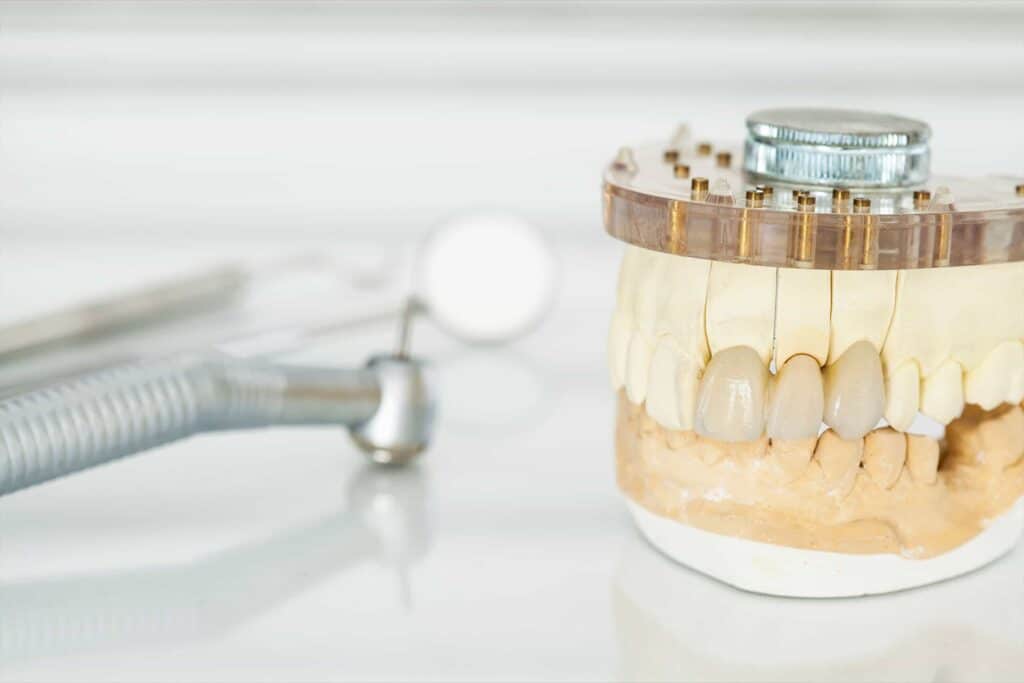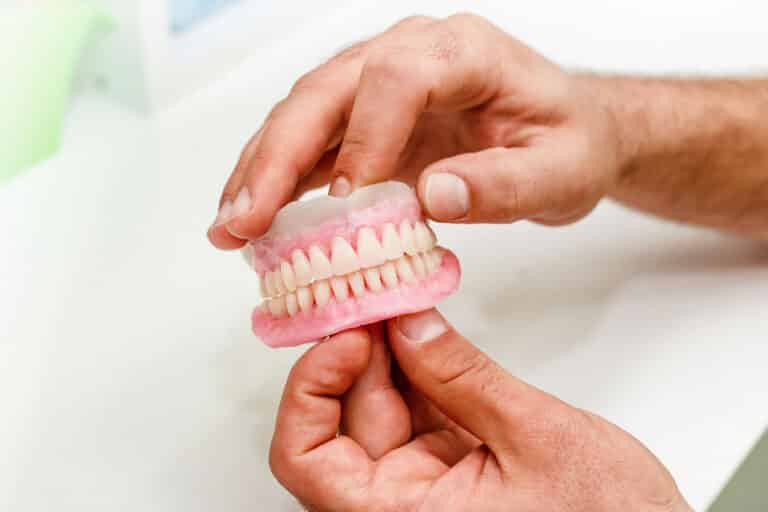When you lose a tooth, regardless of the reason, you’ll need to have it replaced for both aesthetic and functional reasons. Having your tooth replaced can help you to feel more confident about your appearance, help you chew, and protect your oral health.
There are three main options for replacing a missing tooth.
Option 1: A Dental Implants
Your first option to replace a missing tooth is to get a dental implant. A dental implant is a medical device that is surgically implanted into the jaw. It has an implant body, an abutment, and a crown – it may also include an abutment fixation screw.
The body of the dental implant is the part that is surgically inserted in place of the missing tooth’s root.
Pros of a Dental Implant
- Has one of the highest success rates amongst all dental treatments.
- It functions just like a natural tooth.
- Dental implants restore the cosmetic appearance of your smile (the crown looks like a traditional tooth) and has the best esthetics.
- It helps to keep the jawbone from shrinking due to bone loss.
- Dental implants preserves the health of the surrounding bone and gums.
- They look like a natural tooth.
- They help nearby teeth stay stable.
- They are a permanent replacement.
Cons of a Dental Implant
- During place of dental implants, there can be damage to the surrounding natural teeth or structures like nerves.
- It requires surgery and may need additional grafting.
- If the implant doesn’t take, there can be significant bone loss.
- If the retaining screw loosens, there can be a sensation that the tooth is loose or twisting.
- The implant body can become loose for a variety of reasons.
- There can be challenges cleaning the gums around the implant, which leads to poor oral hygiene.
Option 2: A Dental Bridge
Your second option to replace a missing tooth is a dental bridge. It literally “bridges” the gap created by one or more missing teeth. Unlike implants, they don’t replace the roots of your missing tooth.
Instead, it uses one (or more) of the teeth adjacent to the gap as the anchor for attaching a crown in the space of your missing tooth.
Pros of a Dental Bridge
- A single dental bridge can replace multiple missing teeth, making it a good option if you need to fill the gap from more than one tooth missing.
- Requires that your remaining teeth around the dental bridge are in good health.
- It doesn’t require surgery. Since it anchors off a surrounding tooth, it’s a quick outpatient procedure.
- Dental bridges provide security – the healthy teeth acting as anchors provide a great deal of support.
- Bridges can feel very natural and look much like traditional teeth do.
- Functions like natural teeth.
- A more permanent options than a denture.
Cons of a Dental Bridge
- You need healthy surrounding teeth. If you don’t have healthy neighboring teeth for the dental bridge to anchor to, you won’t be able to get one.
- Bridges won’t address or help to prevent bone loss. Since the tooth root isn’t replaced when it is placed, the jawbone in that area will begin to deteriorate.
- Bridges will need replacing. The expected lifespan is 15 years, so you’ll likely need to replace it in your lifetime.
- They are harder to clean than implants, as you will need to floss under the bridge to keep it clean.
- If you get a cavity under the bridge, the entire piece usually needs to be replaced.
Option 3: Partial Dentures
Your final option is a partial denture. They are made from a combination of acrylic and metal materials. It’s a removable, but natural-looking appliance that can restore the look and function of your jaw.
Pros of Partial Dentures
- Partial dentures are the least invasive option compared to bridges and implants. Surgery is not needed for most people and if any modifications need to be made to the existing teeth, they are very minor.
- Partial dentures are able to replace the maximum number of missing teeth in a jaw.
- If you lose additional teeth in the future, you can add teeth easily to partial dentures.
Cons Partial Dentures
- Partial dentures function the worst compared to bridges and implants, they are not as strong as the other replacement options.
- There can be slight movement with these dentures when chewing which can rub against the gums and be uncomfortable.
- They have the poorest esthetics compared to bridges and implants. This is especially true when the clasps, metal or plastic, are visible.
- Adjusting to these dentures can be a lengthy and challenging experience.
- Since the dentures aren’t attached to the jawbone, you will experience bone loss over time.
- The thickness of the dentures can affect speech.
Can Veneers Replace a Missing Tooth?
No, veneers cannot replace missing teeth since they are thin coverings placed on the front of an existing tooth. They look like natural teeth and can be used to solve a variety of esthetic dental issues, such as stained, chipped, or worn teeth.
While they can greatly improve the esthetics of existing teeth, they cannot be used to replace missing teeth.
Can You Replace a Missing Tooth at Home?
DIY tooth replacements are inadvisable for many reasons. The at-home replacement products often do not feel like real teeth, nor do they function like real teeth. Additionally, the products can contain ingredients that are not FDA-approved.
Finally, at-home treatments do not last nearly as long as professional replacements do. We do not recommend DIY replacement as one of our options for replacing missing teeth. This is definitely not an option that your dentist would support.
What’s the Best Method to Replace Missing Teeth?
The best way to replace a missing tooth will depend on your goals and your overall oral health. If you have enough bone in your jaw to consider an implant and are willing and able to undergo surgery, an implant is considered by most dental professionals to be the best way to replace a missing tooth.
It will also be the most realistic replacement for your missing tooth. With the new improvements in technology, implants are considered to be the gold standard for missing teeth.
A bridge is one of the most stable replacement options for missing teeth, but it comes with cleanseability issues. The health of the surrounding teeth can be compromised if you aren’t diligent about cleaning around your bridge effectively.
It also requires the placement of crowns on several teeth, which isn’t ideal if those teeth do not already need crowns.
Dentures are easy to keep clean but is the least likely replacement to remain stable. It’s likely to slide around and can irritate the surrounding gums. It also has the worst esthetics and function but is the most cost effective way to replace a lot of missing teeth.
What Does it Cost to Replace a Missing Tooth?
There are a variety of factors that affect the cost of each replacement option.
The cost of a dental implant are affected by the dentist doing the implant, the condition of your gums and jawbone, and the option you choose for anesthesia. The average price of dental implants is around $4,800 but can range from $3,500 – $6,700 depending on various factors. This is the total cost for all three components – the implant surgery, abutment, and implant crown.
A good way to think about the cost of a bridge is to multiply the number of crowns (including replacement teeth) needed by the average cost of a crown. For instance if you are replacing 2 missing teeth, it’s a total of 2 replacement teeth, plus the two anchor crowns for a total of 4 crowns. If a crown costs $1300, then the cost of a 4 unit bridge is $1300 x 4 = $5,200.
The cost of a bridge will vary on a number of factors, including the type of bridge and number of replacement teeth, but it’s often several thousand dollars.
A partial denture range in cost based on the type of dentures being made. Typically, they cost $1,000-$2,500 and will replace multiple missing teeth. They are one of the cheapest options to replace multiple missing teeth.
How Long Does it Take to Replace a Missing Tooth?
The process of each replacement style takes a different amount of time.
Dental Implants
For dental implants, you’ll go through a dental exam and schedule the surgery. The surgery itself will take 1-2 hours, which will allow the implant to be placed. Once this is complete, you’ll typically wait about 3 months to have the final tooth restoration placed so that the surgery site has fully integrated with your jawbone.
n total, it takes around 4.5 months to perform an implant. It can take longer if additional grafting or if the tooth needs to be taken out first and then healed. Sometimes an implant can take a year or so before everything is all said and done.
Although they can take the longest, they are one of the best replacement options for missing teeth.
Dental Bridges
Dental bridges typically take two appointments. The first visit will be 1-2 hours, and your anchor teeth will be shaped and prepared for crowns. Molds of your teeth will be taken, and you’ll receive a temporary bridge.
On the second visit, your dentist will remove the temporary bridge, place the new bridge, and check to make sure it fits. The time from temporary to permanent bridge varies based on what lab is used and a variety of other factors.
Typically the turnaround time is a few weeks.
Partial Dentures
Finally, depending on the type of partial dentures being made, there are several denture steps that need to be completed. Unless there is an inhouse lab, the time between steps is usually 1-2 weeks.
The total number of steps will vary depending on the type of partial. Usually it takes at least a couple weeks to make, but it can take up to a couple months. Keep in mind that even after the partial denture is made, there are almost always a few adjustments that need to be made after it is delivered.
This is one of the quickest options to replace missing teeth.





